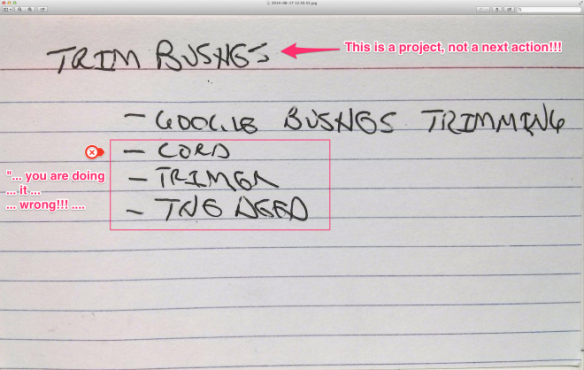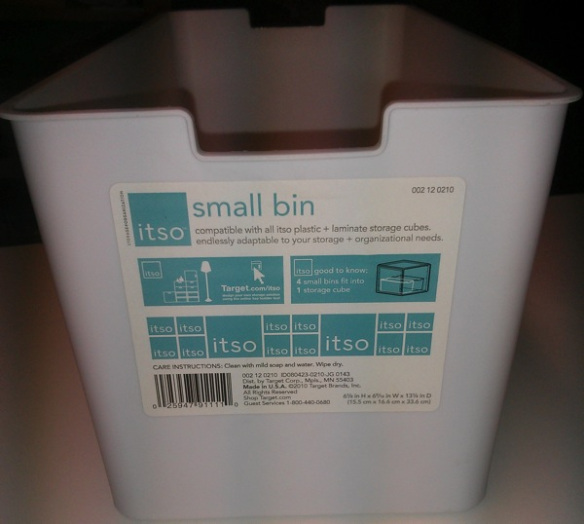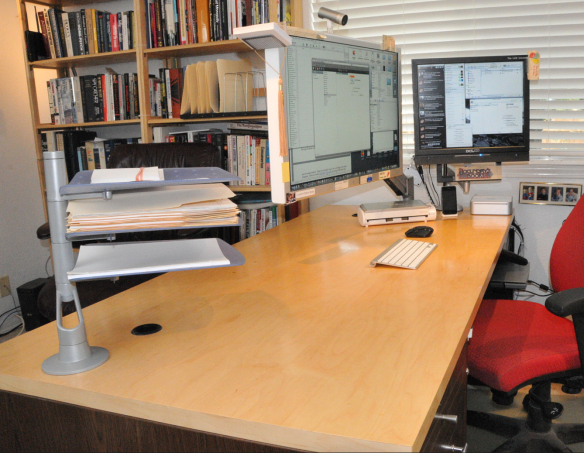Example De Jure Misuse of One Idea One Piece of Paper
This post began as a response to a reader email. In the beginning was R. asking about cards. I’ve expanded the post with pictures and some of my GTD history, in the hope that this post can be a stepping stone for other people on the GTD journey.
R.
Sorry it has taken me so long to get back to you. But, I’ve been looking forward to writing this email ever since I skimmed your message 2 days ago.
On Wed, Aug 13, 2014 at 8:49 AM, R. wrote
R.I am finding one thing extremely difficult to get my mind around.The one idea, one 3×5 card.
I got 1 idea 1 card from David Allen’s “one idea, one piece of paper” which I can’t actually find in GTD, but I came away from GTD thinking it. Whether he said it or not. Or, intended me to take away the 1-idea-1-card concept, the value is 100% in idea modularity.
What I mean by idea modularity, can be seen by comparing separate 3×5 cards with what most people do, which is to carry around a “log book.” I used to carry a log book and paste business cards into them and write notes, mind maps, action items, etc. in them. But there is a problem: log books turn into higgledy piggledy quagmires of open loops.
I would write stuff down, and then never come back to the idea. Which, my subconscious saw, and consequently, my subconscious kept the job of “not forgetting” so I wasted just as much energy remembering, as I would have without the log book.
David allen talks about taking these kinds of log books and blesses using them AS LONG AS YOU GO BACK AND RAKE OUT ALL THE OPEN LOOPS and capture them in a modular way. By modular, I *think* David Allen means taking the idea and getting it into a project folder that the idea relates to. Here is what he says:
David Allen:
“I usually recommend that clients download their voice-mails onto paper notes and put those into their in-baskets, along with their whole organizer notebooks, which usually need significant reassessment.”
Allen, David (2002-12-31). Getting Things Done: The Art of Stress-Free Productivity (p. 118). Penguin Group. Kindle Edition.
By “reassessment” I *suspect* David Allen means the ideas usually are laying in log books in all their chocolaty project goodness, waiting to be articulated as projects, and then converted into next actions. At least when I was keeping log books, I rarely wrote down projects, let alone next actions. In fact, what I usually did was to write down “AI” for Action Item and the wrote down a project (not a next action). And to my brain, projects laying around in their chocolaty project goodness in a log book, were anything but actionable.
So, back to cards …
3×5 cards are modular because they capture the idea in next action form, stack neatly, and they go cleanly into manila project folders. And as I’ve said many times on RestartGTD, when I open up a project folder with note cards in it, and I see all my ideas in one place, ready to go, I have an “ahhhhhhh” feeling of relief at not having forgotten the ideas, and a flash of excitement as I can dive into the project (spread the cards out on my huge dungeon desk) and get going.
Bill Dungeon Desk
For me, being habituated to a trusted system process of getting ideas on cards and cards into folders, enables me to make up project folders for ideas, usually in advance of the folder turning into a real project.
Yeah, this opens a whole new can of worms. How can I make a project for something that isn’t yet a project? I will tell you. I. Do not. Know. But, somehow, my subconscious seems to have gotten a handle on preemptive project definition … via working with a trusted system. Cool!
I start having ideas a month or two or three ahead of projects. So, I just create a folder, and file it in a Target Tote.
Target Tote Action Shot
Target Tote Label
And then once I’ve added 8 to 15 cards to a folder, that folder reaches some kind of critical mass, and the project folder turns into a real project. At that point, I have a realization that those thoughts in THAT folder I started, are now “real” and have to be acted on. *Bing* subconscious has now upward delegated a project to my conscious.
R.After reviewing your from 12-30-13, 3×5 Cards and Manila Folder GTD Startup, I felt that I understood the mechanics of the process you use, but I found myself straining to read how you breakdown 1 idea per card. I saw several lines on every 3×5 card and was unable to translate that to an example of appropriate granularity for ideas.
There is tension in my mind when I write stuff on cards.
ASIDE: Story of Bill starting GTD:
When booting up GTD, I initially used letter paper to capture open loops and thoughts. Just like David allen says.
Generation 1 GTD Desk
This was before I discovered “thematic clumping” folders together in totes from Target. Consequently, all folders were created equal, and I bought large folder organizers, took books off shelves, and had massive quantities of folders (look to the left of the top of the big display and you can see folders in an organizer.
This was a bit much. I only accessed a minority of the folders, and all the folders had letter size paper in them. And the volume of paper began to work on my head. Here is a picture of my tote library of thematic clumps. Turns out there are a lot of ideas in one’s head that when they can be safely captured, flee in delight from staying in the cranium not being forgotten. Who knew?
Thematic Clumps of Captured Ideas
(and some non-recyclable papers)
(and some non-recyclable papers)
But, now I’m way ahead of myself. As GTD began to produce paper, it was a bit much. I was not expecting a lot of refugee ideas from my head, to insist on be resettled in paper, in thematic clumps of Target Totes. So, I took a temporary detour from using paper, and being 100% David Allen, to using OmniFocus.
In fact, I got so carried away with electronic organization I entered 100% of my paper into OmniFocus. Electronic heaven of GTD organizing. The only problem was that I could not stand to sit down to my computer.
Because … all my work was there waiting for me. My desk became a trap. In fact, let’s take another look at my desk:
Does anything stand out about this arrangement? Like the iMax screens (don’t forget, event he iPhone was waiting expectantly)? Note I have subsequently gone to a single monitor, and zero materials (not counting cats) on my desk.
Another David Allen saying that I remember from GTD (but which I cannot find in the Kindle version) is that if you get TOO ORGANIZED, your brain will refuse to use your trusted system. OmniFocus put me face to face with over-organization. A first for me.
Omnifocus, is great. Omnifocus is powerful. But because OmniFocus has built in outliner I was seduced/intoxicated to the dark side of one idea, one piece of paper. I had entire projects outlined with next actions. Project = heading, next actions = list underneath. In fact, reflecting, this is better but from my brain’s perspective, not different, from the land of higgledy piggledy quagmire log books. And my brain did not like it. So my brain went on a GTD strike, for the old work rules.
So, to wrap up this aside, I had to go back to paper. My brain “gets” paper. But with letter paper, there is so much wasted space. Seems like a lot more wasted space that 3×5 cards. Because I recycle every piece of paper, I thought “3×5 cards must even be less paper to be recycle!” (*Note* which I don’t want any recycling experts reading this, to disabuse me of. :-)
So, I went back to paper, manila folders, but this time, using 3×5 cards exclusively. Sorry the aside got so long, but this sub-story of my GTD journey, is a common GTD occurrence. GTD is a long string of sub-stories.
Articulating sub-stories is a big reason that I started the RestartGTD blog. In fact, this re-telling of the paper to OmniFocus to 3×5 card cycle, made me realize that the thematic clumps of ideas in Target totes, happened, because my brain finally had a repository for thousands of ideas it was not forgetting. Once it could trust me to not lose the ideas, it went (subconsciously) full bore to dumping the ideas to long term storage in my trusted system. *Note* to self, people implementing GTD for the first time, might want to plan for a lot of resettling of ideas on to paper or whatever their brain likes as a storage media.
ENDASIDE: Story of Bill starting GTD
When I’m writing ideas on 3×5 cards, I don’t discipline myself to a single idea per card. You caught me!
Only one idea per card, feels like wasting paper, just as using letter sheets felt like too much waste. So, if the ideas are related to the same project, because I’m a cheapskate|undisciplined, I’ll write multiple ideas per card. Or, like the card at the top of this page, I will sometimes title with a project, and then bullet with next actions to complete the project.
However, you will be heartened to know that while I’m writing the 2nd and 3rd ideas on the card I’m thinking “You’re doing it wrong. One idea, one piece of paper!” I just don’t listen to myself, because I want fewer cards to do the work. And in many cases, a card is enough for a honey-do project like trimming bushes.
R.I believe I am way ahead of where I would be if I only had the GTD book in attempting to implement GTD.
REMEMBER: GTD is not about “doing it right.” GTD is about hacking your own brain by building a system around it, that your subconscious can use to make you look like a genius. Life in GTD is experimentation, discovery, planning, de-planning, refactoring your system, and trying again. Originally I intended RestartGTD to become a sharing platform for people who bump up against hard issues with GTD, sharing their success with others.
GTD as David Allen does it, is a highly weaponized system for sales people. But, most of us are not sales people. So we have to listen to our feeling, intuitions, and and make efforts to test, evaluate, and reflect on what is pleasurable, as well as what works.
Hope this helps!
bill meade



